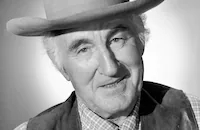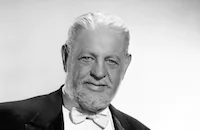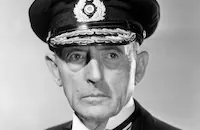The Amazing Doctor Clitterhouse

Brief Synopsis
Cast & Crew
Anatole Litvak
Edward G. Robinson
Claire Trevor
Humphrey Bogart
Allen Jenkins
Donald Crisp
Film Details
Technical Specs

Synopsis
Dr. Clitterhouse, a successful and respected Park Ave. doctor, decides the best way to study the criminal mind is to become a criminal. He begins by robbing the safes of his wealthy friends, but soon wants to observe the underworld more closely and test his theory that criminal activity changes the personality. He seeks out Jo Keller, a well-known fence, and is surprised to discover that Keller is a beautiful woman. While the doctor's devoted nurse, Randolph, covers for him, Clitterhouse joins the gang of criminals run by Keller and Rocks Valentine. Jo falls in love with Clitterhouse, now nicknamed "the Professor," but Rocks is distrustful of the doctor's motives and, one night during a fur heist, tries to kill him by trapping him in a cold storage locker. Once the doctor has concluded his experiments on the gang, he goes back to his practice. Rocks trails him, discovers his notebooks, and threatens blackmail. Clitterhouse, who has now completely lost perspective on his own behavior, murders Rocks and with Jo's help hides the body. When Inspector Lane closes in on Clitterhouse, the doctor confesses his crime to a prominent attorney named Grant. Clitterhouse is tried for murder, but is ultimately aquitted on the grounds of insanity, not because of his criminal actions, but because when he is put on the witness stand he undermines his own defense.

Director

Anatole Litvak
Cast

Edward G. Robinson

Claire Trevor

Humphrey Bogart

Allen Jenkins

Donald Crisp

Gale Page

Henry O'neill

John Litel

Thurston Hall
Maxie Rosenbloom
Bert Hanlon

Curt Bois

Ward Bond

Vladimir Sokoloff
Billy Wayne
Robert Homans

Irving Bacon
Georgia Caine
Romaine Callender
Mary Field
William Worthington
Ed Mortimer
Larry Steers
William Haade
Thomas Jackson
Edward Gargan
Ray Dawe
Bob Reeves
Ky Robinson
Winifred Harris
Eric Stanley
Loia Cheaney
Wade Boteler
Mike Lally
Frank Anthony
Libby Taylor
Joyce Williams
Edgar Dearing
John Harron
Hal K. Dawson
Sidney Bracy
Earl Dwire
Monte Vandergrift

Jack Mower

Frank Reicher
Vera Lewis
Bruce Mitchell
Hal Craig
Crew
Milo Anderson
Leo F. Forbstein
Tony Gaudio
Jo Graham
John Huston
Anatole Litvak
Robert Lord
Warren Low
Gilbert Miller
George Parrish
C. A. Riggs
Dr. Leo Schulman
Jack Sullivan
Jack L. Warner
John Wexley
Carl Jules Weyl

Videos
Movie Clip



Trailer
Hosted Intro
Film Details
Technical Specs

Articles
The Amazing Doctor Clitterhouse
Robinson plays the titular Dr. Clitterhouse, a supposedly brilliant criminologist who's convinced that illegal activity can actually change a person's personality. In order to prove his theory, Clitterhouse joins a gang of crooks headed by the aptly-named Rocks Valentine (Bogart), for whom Clitterhouse masterminds a series of heists. Unfortunately, Rocks grows concerned that Clitterhouse's massive intellect will unseat him as the gang leader. This leads to a case of blackmail, a character getting poisoned for the sake of science, and Clitterhouse skirting jail time through an utterly laughable courtroom defense. Perhaps the most incredible thing about this ridiculous script is that it was co-written by a young John Huston!
At least Robinson gets to sink his teeth into a meaty role amidst all the insanity. Bogart is trapped playing yet another brooding tough-guy who badly needs a shave. Bogey was still a few years away from major stardom at this point, and, much like his Warner Bros. counterpart, James Cagney, badly wanted to break free of the gangster carousel that he felt was holding him back. Still, given his lackadaisical approach to becoming a performer, it's a wonder he appeared in any movies at all.
Later in his career, Bogart would admit that the Rocks Valentine character from The Amazing Dr. Clitterhouse was one of his least favorite roles. Robinson, on the other hand, was quite happy with the roles Warner Bros. was assigning him. He had just returned from working on The Last Gangster (1937) at Metro and, admittedly, had other things on his mind besides film work at this time. "I returned to Warner's to make A Slight Case of Murder [1938] from a play by Damon Runyon and Howard Lindsay. I had absolutely no fault to find with the script because it was beautifully constructed and written and it was very funny. Nor did I object in any way to The Amazing Dr. Clitterhouse, which I made next. This was all during 1938 and 1939, and what was happening in the world made the making of movies seem almost absurd: Anschluss with Austria; the Russian invasion of Finland; Munich; Chamberlain's peace in our time; the Russo-German Pact; The War. I have made no bones about the fact that I belonged to and supported every organization that was opposed to Hitler" (from Robinson's autobiography, All My Yesterdays.)
When The Amazing Dr. Clitterhouse opened theatrically, it was well received by most reviewers and moviegoers. Variety called it "an unquestionable winner" and went on to note that "Robinson...is at his best" and "Bogart's interpretation of the gangster chief...is topflight." Anatole Litvak, who had only directed one other film at Warners (Tovarich, 1937), proved he had a knack for crime melodramas with The Amazing Dr. Clitterhouse and went on to helm such distinctive efforts as Confessions of a Nazi Spy (1939), Castle on the Hudson (1940) and City for Conquest (1940).
Producers: Anatole Litvak, Robert Lord
Director: Anatole Litvak
Screenplay: John Huston, John Wexley (based on the play by Barre Lyndon)
Cinematography: Tony Gaudio
Editor: Warren Low
Music: Max Steiner
Art Design: Carl Jules Weyl
Costume Design: Milo Anderson
Principal Cast: Edward G. Robinson (Dr. Clitterhouse), Claire Trevor (Jo Keller), Humphrey Bogart (Rocks Valentine), Gale Page (Nurse Randolph), Donald Crisp (Inspector Lane), Allen Jenkins (Okay), Thurston Hall (Grant), John Litel (Prosecuting Attorney), Henry O'Neill (Judge), Maxie Rosenbloom (Butch).
BW-87m. Closed captioning.
by Paul Tatara

The Amazing Doctor Clitterhouse
The Amazing Dr. Clitterhouse - Edward G. Robinson, Claire Trevor & Humphrey Bogart Star in THE AMAZING DR. CLITTERHOUSE on DVD
When Robinson started work on The Amazing Dr. Clitterhouse (1938), he had recently signed a new contract with Warner Bros that gave him unusually great autonomy. Warners was presenting him with gangster script after gangster script, however, and Robinson was getting sick and tired of not being offered something different. After starring in, ironically, the MGM picture The Last Gangster (1937) as yet another crime figure, he did two crime comedies for Warner Brothers: A Slight Case of Murder (1938), in which he played a criminal with a comedic slant, and then The Amazing Dr. Clitterhouse, in which he played a doctor trying out a life of crime for "research" purposes. Despite still being crime films, in other words, these were comedic ones in which Robinson was able to edge farther and farther away from playing a serious villain. Slight Case is a "gangster comedy," but Clitterhouse is more of a comedy set in a gangster world.
Robinson clearly enjoyed the chance to flex different acting muscles; one can sense it watching Clitterhouse. Robinson's "Dr. Clitterhouse" character is a respectable, wealthy doctor who we see in an intriguing opening sequence clear the jewelry from the safe of his high-society hostess, catching some other "real" crooks in the process, and then casually rejoining the cocktail party downstairs. Soon it's clear that Dr. Clitterhouse is transfixed on studying the criminal mind by engaging in criminal acts himself. He's interested in the criminal's bodily response to crime - the effects on pulse, heart rate, blood content, mental state, etc. After a few robberies on his own, he worms his way into a gang led by Humphrey Bogart and Claire Trevor and manages to become their leader, known as "The Professor." After each robbery, Dr. Clitterhouse takes blood samples from and conducts exams on each gang member - except for the suspicious Bogart, who is resentful because of his power being stripped away and of the burgeoning romance between Trevor and Robinson. The crooks write off The Professor's bizarre behavior as just an oddity of a man who otherwise is arranging one successful job after another.
Of course the plot is ridiculous, but it succeeds in generating much amusement. When Robinson's nurse urges him not to go ahead with his plan, Robinson justifies it by saying, "If I accept my purpose, I believe I'll be making a very important contribution to society worth whatever personal risk it may entail." At that point, the audience simply has to go along with the craziness.
Bogart, who had just appeared in Racket Busters (1938) and would next do Angels With Dirty Faces (1938), is in full tough-guy mode here and is as enjoyable as ever. Claire Trevor was on the cusp of stardom, but then again, she would pretty much remain there without ever truly breaking through. She'd been in movies since 1933 and had recently been Oscar-nominated for Dead End (1937) - and was still to appear in such smash hits as Stagecoach (1939) and Murder, My Sweet (1944) - but her heart was simply geared more toward theater than film. Nonetheless, she is awfully good here, and her chemistry with Bogart is especially appealing. Rounding things out are the studio's top-level stock company of supporting players: Allen Jenkins, Donald Crisp, Henry O'Neill, Ward Bond and others.
Warner Home Video's DVD comes with many extras: a commentary from USC film professors Drew Casper and Richard Jewell, two shorts, a cartoon, a newsreel, trailers, and two radio versions of the story featuring Robinson. Most of the extras can be viewed a la carte or as a "Warner Night at the Movies" option. The film is only available as part of the entire box set. Each of the other discs (the titles are The Little Giant, Kid Galahad, Invisible Stripes and Larceny, Inc.) has similar extras, and as a whole, the collection lives up to the exemplary standards created by previous releases, including excellent picture and sound. The best bonus is a separate disc for the brand-new, feature-length documentary Public Enemies: The Golden Age of the Gangster Film. Even that disc comes with extras: an assortment of more classic Warner Brothers cartoons, gangster-themed.
For more information about The Amazing Dr. Clitterhouse, visit Warner Video.To order The Amazing Dr. Clitterhouse, go to TCM Shopping.
by Jeremy Arnold
The Amazing Dr. Clitterhouse - Edward G. Robinson, Claire Trevor & Humphrey Bogart Star in THE AMAZING DR. CLITTERHOUSE on DVD
Quotes
Trivia
Notes
The play was produced in association with Warner Bros. After the New York production, the studio had some difficulty obtaining the movie rights to the play because Barre Lyndon retained control of the movie rights and placed the play on the open market. According to Los Angeles Times, other bidders were Carl Laemmle Jr., Paramount and M-G-M. Variety reported that Laemmle purchased the play for a sum in excess of $50,000 and then, according to the Los Angeles Examiner, sold it back to Warner Bros., in exchange for the loan of Paul Muni whom Laemmle wanted for The Hunchback of Notre Dame. Irving Rapper was originally assigned to the film as dialogue director, but was replaced by Jo Graham. According to a news item in Citizen News, Ronald Colman was Robert Lord's choice for the role of Clitterhouse. Warner Bros. press releases noted that a number of prominent silent stars appear in the film in featured or bit roles.

Miscellaneous Notes
Released in United States 1938
Released in United States 1995
Shown at the Museum of Modern Art (Screen Plays: From Broadway to Hollywood, 1920-1966) in New York City on October 1 and October 6, 1995.
Released in United States 1938
Released in United States 1995 (Shown at the Museum of Modern Art (Screen Plays: From Broadway to Hollywood, 1920-1966) in New York City on October 1 and October 6, 1995.)















